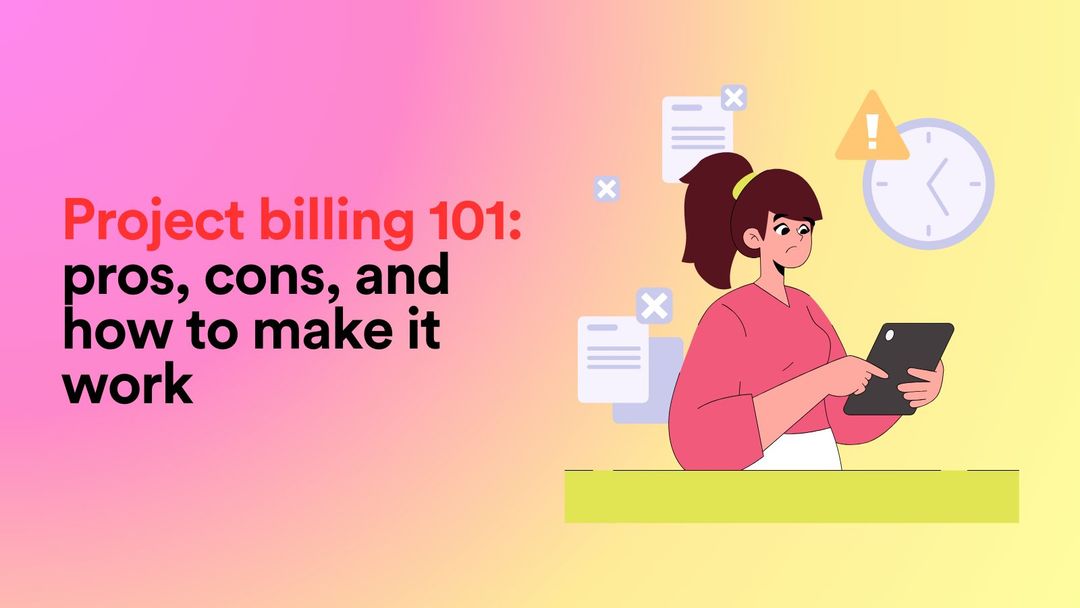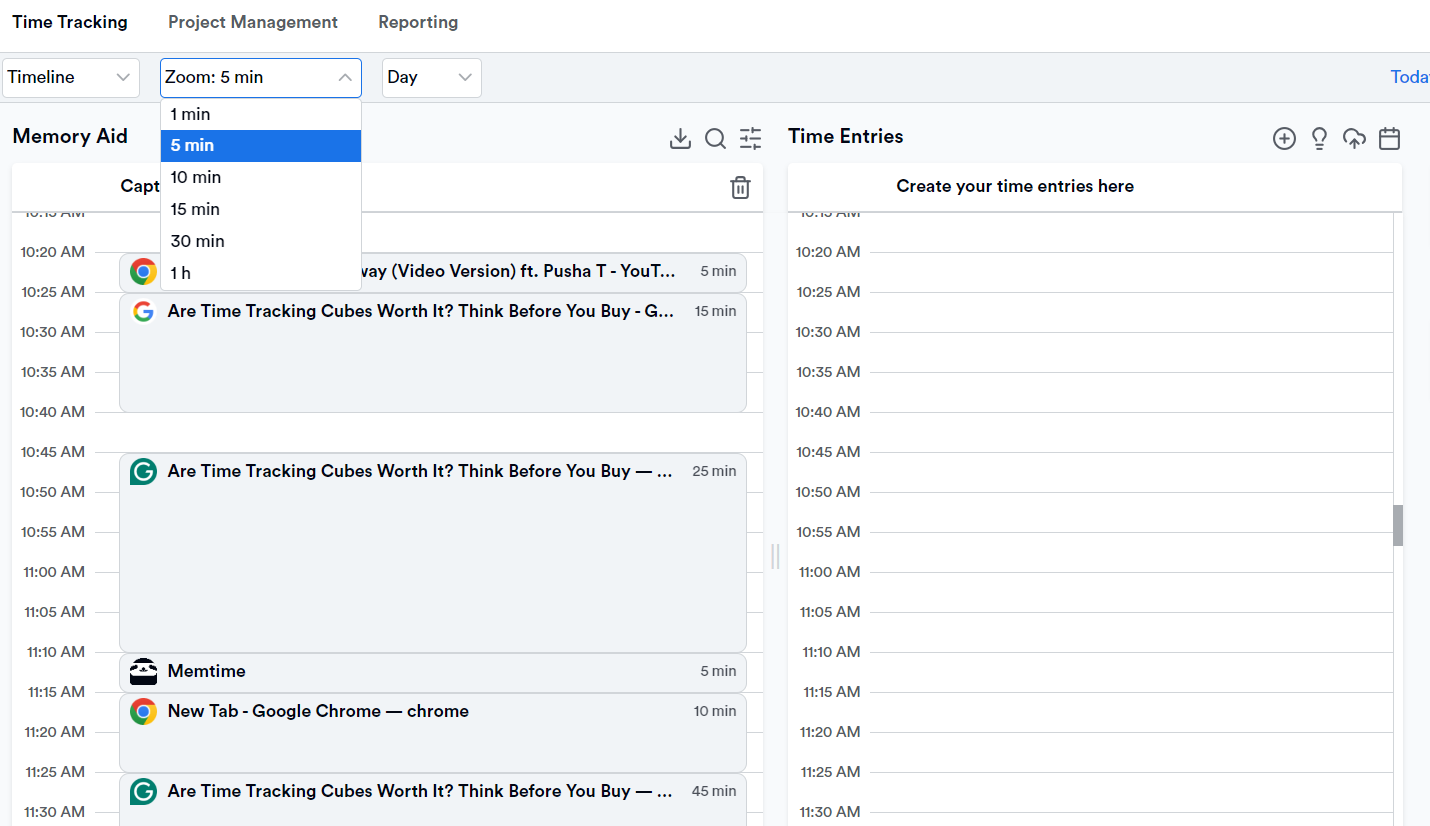Project Billing 101: Pros, Cons, and How to Make It Work

Welcome to project billing. A place where agencies promise clients the whole galaxy, then discover they actually quoted them for a glittery party stick. *cueing nervous smile*
If you’ve ever found yourself saying, “Oh, it’s just a quick, little project, how bad could it be?”, right before your team logs 300 hours designing a logo variation, you already know the darkness that comes with project billing.
You gamble with scope creep like you’re in Vegas.
You pray to the billing gods to make your time estimates accurate this time.
Project billing can be such a scramble, with no strategy in sight.
But it doesn’t have to be that way.
Let’s go through the highs, lows, and the “wait, are we actually losing money on this?” moments of project billing and throw in some foolproof tips on how to make it work.
It’s time you finally stop crying when sending your invoices and immerse yourself in running a profitable, drama-free agency. 💰

What is project billing?
Project billing means agreeing on a price and payment plan for a defined project scope or outcome, then invoicing and collecting payments according to that plan.
It works brilliantly when done right, but can be really problematic in the wild.
Why?
Well, because underestimation, scope creep, cash flow gaps, and pricing pressure can quickly turn a once profitable project into a money pit. That’s why project billing combines art and science: you need to understand the lifecycle of a project, stick to strict processes at each stage, and track performance so you can protect your margins and keep clients happy.
Understanding the project lifecycle
Within the project lifecycle, there are 11 key phases of project billing.
Here’s a breakdown of those phases, their goals and outputs, why each of them matters, and tips for handling each phase properly.
Now that you know the 11 key phases of the project lifecycle, you can see how each step helps keep projects organized and profitable.
But knowing the lifecycle is just the start; the way you actually charge for your work can have a big impact on your agency’s margins.
Let’s take a look at the 4 main project billing methods, from fixed price to value-based, so you can find the approach that best fits your projects and workflow.
Understanding 4 project billing methods
Every project has its own rhythm and its own way of being billed. Picking the right billing method can help protect your margins, keep clients happy, and make cash flow a lot easier to manage.
Here are the 4 main project billing methods, along with their characteristics, advantages, and drawbacks.
#1 Fixed price billing
A fixed price contract allows you to set a predetermined total fee for a defined deliverable, like a website redesign or an app. The scope, timeline, and cost are agreed upon upfront.
These projects come with predictable costs; clients know the exact amount they’ll pay, and you both understand the project’s scope and outcomes.
In terms of time, you are motivated to complete the project efficiently, as the fee is fixed, so you’re not being “punished” for being efficient, like with hourly billing.
However, there’s a risk of scope creep. Any changes or additions to the project scope can lead to additional costs, and adapting to new requirements is never easy. Plus, if the initial estimate is too low, you will be covering all those unexpected costs.
#2 Milestone-based billing
In this method, you receive payments when you complete project milestones, like a design approval or final delivery. This billing concept allows you to break the project into phases, with clients paying after the successful completion of each phase.
This billing model is fair for you and the client; you receive payments at regular intervals, and clients can monitor the project’s progress at each milestone. On top of that, you can easily adjust between phases based on feedback or changing requirements.

However.
Delays in one phase affect the following payments and project timelines. Plus, if there are any disagreements over milestone completion, you can expect late payments.
#3 Time & materials (with a cap)
This model involves billing clients based on the actual time spent and materials used, with an agreed-upon maximum limit (cap). Basically, you get time and materials billing combined with the predictability of a capped budget.
If you use this model, you’ll be able to adapt to changes and unforeseen circumstances without having to renegotiate. Plus, clients can see exactly what they're paying for in terms of time and resources, and there’s a cap as a safety net for them, so there’s no additional cost.
Disagreements can happen over what is considered billable time or necessary materials.
#4 Value-based billing
This concept combines elements of fixed price, time and materials, and milestone billing. Often, there’s a base fee plus a success fee tied to the value delivered to the client.
With this type of billing, you and your client are motivated to achieve the best possible outcomes. And the good news is that you can earn more if you deliver additional value.
To make it work, you need clear contracts that outline success metrics and payment terms, since defining delivered value can often be subjective and tricky.
Pros & cons of project billing
Project billing can affect all your operations. By that, I mean: if it’s executed properly and consistently, it can boost profitability, support good client relationships, and reward you for your efficiency. But if you are not careful, it can ruin your margins.
Here’s a list of the most common pros and cons that come with real projects, no matter the billing method.
Pros of project billing
- You can be predictable with pricing. When clients know upfront what they’ll pay, it builds trust, gets you easier internal approvals for clients, and quicker onboarding.
- You get more predictable revenue. Just think of all the milestone payments or fixed price projects; you can anticipate cash flow more reliably, and with no stress.
- You are more focused on the impact and value. Project billing allows you to set pricing around deliverables instead of hours worked. You’re focused on promised results, and so are clients.
- You get rewarded for being efficient. When fees are fixed, teams are motivated to work smarter, not just longer. This means you can focus on optimization, reuse templates, and do better project management.
- You can get better at scope management. Project billing forces you to define deliverables, timelines, and expectations as clearly as you possibly can. Doing so creates a well-defined scope that eliminates potential conflicts.

Cons of project billing
- You can underestimate a project's time, resources, and complexity. And when that happens, you turn a profitable project into a loss. Your team may have to work overtime, as your business is the one absorbing the cost of extra effort.
- Scope creep is always on the horizon. If you don’t implement a strict change-order process, clients can request “just one more thing” beyond the agreed scope. That unpaid work can accumulate and negatively impact profitability.
- There are always variations in profitability. Two projects with the same fee can require different levels of effort. If you don’t track actual hours and tasks, it’s hard to predict those margins.
- You can have long periods without cash inflow. Milestone payments or end-of-project invoicing can force you to opt for alternative revenue streams.
- There’s a chance of admin overhead. Each project requires proposals, SOWs, contracts, and approvals. All these contracts take time away from delivery, especially if your processes aren’t standardized (or automated).
How to make project billing work for you
Now that you know the pros and cons of project billing, it’s time you learn how to prevent each of the cons we discussed earlier.
Here’s a list of each downside, followed by a practical solution you can implement today.
#1 Underestimation
One of the biggest profitability killers is underestimating how much time and effort a project really takes (thanks, planning fallacy). On paper, a project can look like smooth sailing. In reality, it comes with hidden complexities (you haven’t accounted for), and your team ends up working late nights just to stay on track.
The best fix? Ground your estimates in real data.
That’s where Memtime comes in. 🙌
Memtime is our fully automated time tracking tool that quietly records your entire workday in the background. No start/stop buttons, no forgetting to log hours.
It captures everything: apps, files, emails, meetings, even calls, and lays it out in a detailed timeline, the Memory Aid.

Here’s what it can do:
- It captures every app, file, browser tab, and email you work on. Even meetings and calls (yes, it even logs phone calls if you’re on macOS, or using VoIP systems like Sipgate, Pascom, or FRITZ!Box).
- Provides you with a timeline view that shows your day chronologically, so you can later assign time entries to projects without guesswork.
- It integrates with 100+ project management and billing tools, so your data flows directly into the systems you already use. It does so using a two-way sync, meaning you can import projects and tasks and then export time entries to those projects in just a couple of clicks.
- It has a privacy-first design, meaning all data is stored locally on your computer, not in the cloud. You decide what (if anything) to share.
What does this all mean?
Well, because Memtime captures everything automatically, you’ll always have a precise record of how much time different tasks and projects actually take. Over time, this creates a goldmine of historical data that makes future estimates more accurate.
You’ll see exactly how long similar projects and tasks took in the past. Then, you’ll build a bank of historical data that makes your estimates realistic and profitable.
With Memtime, underestimation becomes a thing of a past.
If you’re ready to see what Memtime is all about, start with our 2-week free trial (no credit card required!), so you can use all of its data as your secret weapon for realistic quotes and buffers.
Or you can schedule a 15-minute call. We’ll show your team how Memtime works, answer your questions, and explain how to get the most out of it.
#2 Scope creep
You’ve probably been in this situation: the client is happy, the project is rolling along, and suddenly they say, “Could we just add this little thing?”. Next thing you know, one small request turns into another, and you’re working hours you’ll never bill.
The fix is about establishing boundaries and processes.
Define the scope clearly up front, and then set up a simple change-order process. That way, when new requests pop up, they’re logged, priced, and approved BEFORE work begins. Clients still get flexibility, but you don’t lose money or sanity in the process.
Now, scope creep is mostly about boundaries and process. But time tracking with Memtime can give you the proof you need when things start slipping outside the original agreement.
Since Memtime automatically logs every app, document, browser tab, and even calls, down to the minute, it gives you a clear record of where the team’s time is really going. So when a client says, “That was just a tiny request”, you can actually show the extra 17 hours spent tweaking designs or rewriting copy.
That data makes unpleasant conversations way easier; there’s no gut feeling, just hard evidence.
I like to say that Memtime gives you the receipts so you can keep scope creep under control. 🙂

#3 Variations in profitability
As mentioned before, two projects can have the same fee, but one might soak up way more hours and leave you with thin margins. This is what makes profitability so unpredictable.
The way to fix it is, yet again, by tracking actual time and effort across all projects. Once you know how much each type of work really costs in hours, you can spot which projects are profitable and which ones need a pricing adjustment.
Use your data to work smarter. Use Memtime.
#4 Cash flow gaps
Another issue with project billing is cash flow. If your invoices are tied to major milestones or the project’s completion, you could go weeks or even months (yikes!) without receiving payment. That puts pressure on your business even if the project itself is going well.
To fix this, structure payment terms more strategically. For example, ask for deposits, spread payments across multiple checkpoints, or use progress billing.
Smaller, more frequent payments keep cash moving, so you’re not struggling to cover expenses while waiting for that single big invoice.
#5 Admin overhead
Let’s not forget about the paperwork. Proposals, contracts, approvals, and invoices are all essential, but all eat into the hours you could spend on delivery. If your paperwork-related processes aren’t streamlined, admin quickly piles up and feels like a second job.
My suggestion is to standardize and automate.
Create templates for proposals and contracts, set up approval workflows, and connect your billing and time tracking tools. The less time you spend on repetitive admin, the more time you have for actual project work (and billable hours).
This is where Memtime helps, too. Because it automatically tracks every minute of your workday in the background, you don’t waste time filling in timesheets or manually logging hours for billing. Instead, Memtime builds a detailed, accurate timeline of your activities, allowing you to assign time entries to projects with just a few clicks.
Memtime cuts down admin, with fewer manual entries, and no more chasing team members for missing timesheets.
Wrapping up
There you have it.
Project billing in all its messy glory. It can feel daunting to even negotiate a project, but with the right processes (and tools!), it doesn’t have to be a horror show. You can reach all those bombastic margins, I promise you.
So, get your scope tight, your data tighter, and let Memtime do the boring time tracking part so you can actually focus on running your agency.
Good luck, and may your clients always be happy! 🍀
FAQs
What is project billing, and why is it important?
Project billing is the process of agreeing on a price and payment plan for a defined project scope or outcome. It’s important because it ensures your agency gets paid fairly and protects profit margins. Done right, it improves client trust and makes cash flow more predictable.
How can I prevent underestimating project time and costs?
Underestimation happens when time, resources, or complexity aren’t accurately accounted for. Using historical project data and tools like Memtime can help track how long tasks really take, so your estimates are realistic and profitable. Grounding your quotes in real data helps prevent lost revenue and overworked teams.
What strategies can stop scope creep from hurting profitability?
Scope creep occurs when clients request extra work beyond the agreed scope. Setting clear project boundaries and using a simple change-order process ensures any additions are logged, priced, and approved before work begins. Memtime also helps by showing exactly how much time was spent on requests, providing hard evidence during discussions.
Which project billing method should I choose?
Picking a project billing method isn’t easy; every project (and client) has its own “vibe”. Fixed price gives you predictability, milestone-based spreads payments across project checkpoints, time & materials tracks effort while keeping a safety cap, and value-based ties your fee to the results you deliver. The trick is to match the method to your project type, client expectations, and cash flow goals, so everyone’s happy and you get paid fairly.
How can I avoid cash flow gaps in project billing?
Cash flow gaps happen when payments are delayed due to milestone or end-of-project billing. Structuring payments strategically, like deposits, multiple checkpoints, or progress billing, keeps money flowing steadily. Smaller, regular payments prevent scrambling to cover operational expenses.
Can I reduce admin overhead while managing project billing?
Of course! By standardizing templates, automating workflows, and connecting your billing with time tracking tools, you can cut down hours spent on proposals, contracts, and approvals. Memtime makes this even easier; it quietly logs your team’s work in the background and integrates with over 100 project management and billing tools. That means fewer manual entries, less chasing timesheets, and more time for the work that actually pays.
Aleksandra Doknic
Aleksandra Doknic is a copywriter and content writer with six years of experience in B2B SaaS and e-commerce marketing. She's a startup enthusiast specializing in topics ranging from technology and gaming to business and finance. Outside of work, Aleksandra can be found walking barefoot in nature, baking muffins, or jotting down poems






